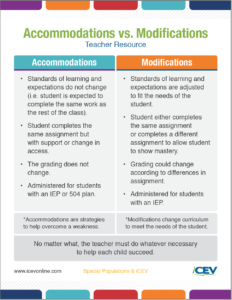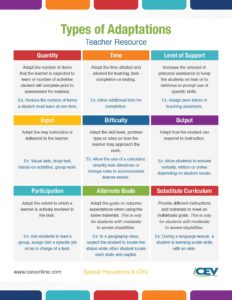Career and Technical Education (CTE) | Special Populations
Special Populations & iCEV: Accommodations, Adaptations & Modifications
For some teachers, the difficult part of teaching isn’t content: it’s differentiation. Fifty years ago, classrooms were organized in a teacher-centered manner focusing primarily on completing coursework. As we get deeper into the twenty-first century, teachers are expected to implement a variety of teaching strategies into each lesson, and those with special populations have even more pressure to teach accordingly.
Fourteen percent—7.0 million—of all public school students in 2017-2018 had a disability. Each of these students has an Individualized Education Program (IEP) describing the student’s needs and how best to adapt the lesson to fit those needs. IEPs provide information on implementing accommodations and modifications.
Accommodations vs. Modifications
To begin, accommodations and modifications are not the same; each has a specific purpose. An accommodation is in place to help a student overcome a weakness. It does not change the curriculum, grading or expectations. The student is completing the same assignment as the rest of the students, but he or she is provided with support to help them succeed. Modifications, on the other hand, change the curriculum and expectations. A student with a modification on their IEP is unlikely to succeed without additional support.

Accommodations
Accommodations are about adapting the instruction to fit each student’s needs. There are nine generally accepted types of adaptations:
- Quantity
- Time
- Level of Support
- Input
- Output
- Difficulty
- Participation
- Alternate Goals (only for students with moderate to severe disabilities)
- Substitute Curriculum (only for students with moderate to severe disabilities)
When teaching individuals in special populations, there is no one-size-fits-all mentality. What works for one student may not work for another, and accommodations often change according to the lesson. The student’s IEP will determine which type of adaptation he or she needs, but it is up to the teacher to determine how to incorporate the adaptation into their curriculum.

Modifications
Many teachers struggle more with modifying assignments rather than adding accommodations. When making modifications to lessons and assignments, there is a fine line between making the assignment too simple and modifying to fit a student’s needs, yet still presenting a rigorous challenge for the student. Unlike adaptations, there is not a standard list of modifications, and each course and/or grade level requires specialized changes. For CTE courses, implementing one or more of the following is a good start:
- Computerized spell-check
- Word bank of choices for answers
- Video supplements in place of reading text
- Rephrase questions into easier to understand language
- Projects in place of written assignments (or vice versa)
- Modified workload or length of assignments
- Alternate projects or activities
- Change in grading system
Applying modifications requires some trial and error. Communication between student and teacher is crucial when finding the right learning strategies to best help each student succeed. Teachers must remain flexible; what worked at the beginning of the year might change throughout the semester as the student grows in both knowledge and confidence.
“Fair is not equal.”
One of the most important things for teachers to keep in mind when teaching is that fair is not equal. Providing accommodations or modifications for one student but not the rest can cause students or parents to question fairness. The teacher is in no way favoring a student who has an IEP or providing access to support to help one student better than another. Rather, he or she is providing ways to help a student succeed in an environment where they would otherwise be unable to do so. Not every child requires additional support to thrive in particular courses. The teacher is individualizing learning for each student they teach, and students without disabilities are given as much attention and support as those with disabilities.
For strategies to help your special populations students succeed, download the free guide:
